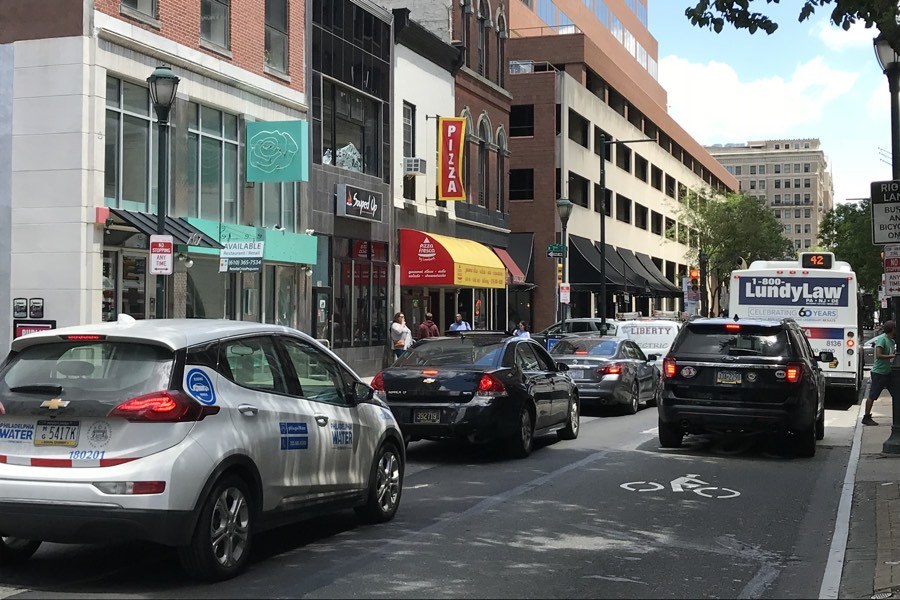How the New Chestnut Street Loading Zones Can Help Curb Congestion
You’ll start noticing changes on Chestnut Street soon. Here’s what to expect — including, we all hope, less traffic.

Midday traffic along Chestnut and 7th Streets in Center City. Photo by Ella Comberg.
No one likes driving on Chestnut Street. Absolutely no one. I say this as a fact.
At all times of the day, the road feels like a serious contender for the most congested street in Philly — which, by the way, just ranked as the third-worst city for drivers in the nation, per a Wallethub study. So Philly plans to do something about it — temporarily, at least.
Last week, the Office of Transportation, Infrastructure and Sustainability revealed plans for a loading zone pilot on Chestnut Street. Officials had included proposals for loading spots, or sections of a street designated for short-term passenger or freight loading or unloading, last year in the city’s anti-congestion plan, CONNECT.
At the time, the city touted CONNECT as its first ever multi-year “strategic” transportation proposal, framing it as an effort to set traffic grid intentions over the next seven years while helping city departments work with stakeholders on those goals. Among other things, CONNECT prioritizes plans to revamp the city’s bus network, improve public transit, increase bike ridership, cut down on congestion, and ramp up funding for streets projects. (You can read more about it here.)
What to Expect
The temporary loading zones, which went into effect earlier this month, will function as the city’s latest CONNECT-related project. According to the recent OTIS announcement, you’ll find them on every block of Chestnut Street between 20th and 6th streets. The 80-foot-long passenger and freight loading zones will be marked by bright yellow paint and black horizontal lines.

The spots, available all day, will offer 20-minute time limits for loading. They’ll be situated on the western end of each block. In addition, the road’s 20-foot handicap parking spaces will be moved to the eastern ends of each block. A two-hour enforced meter parking time will be in effect on the remainder of the blocks between 6 a.m. and 2 a.m. Some blocks will also include reserved motorcycle parking, valet parking, and spaces for Indego bike shares.
The city will evaluate the effectiveness of the loading zones over the next six months, monitoring changes in bus travel times, changes in private vehicle travel time, PPA meter revenue, ticketing and more.
The Need for Loading Zones
As outlined in CONNECT, congestion can be a sign of a city’s prosperity — and some level of traffic in such a densely built area seems just plain unavoidable. At the same time, as businesses and housing projects multiply, construction projects abound, and Philadelphians own more cars than ever (the number of vehicles registered in Philadelphia has increased 68,000 in the last eight years alone), it becomes more and more obvious that our streets are public spaces with many competing uses.
A signficant share of recent streetscape demand derives from ride-sharing vehicles and delivery trucks. When vehicles like these have nowhere to park temporarily, they occupy space in the travel lane, blocking traffic. (Virtually everyone who has driven in Philadelphia has experienced this, I’m sure, and knows the frustration of sitting behind or navigating around a truck with hazard lights — especially on Chestnut Street.)
Instead of treating what is a clear demand for short-term parking as a traffic nuisance, the city is opting to better streamline the traffic grid by making space for that need. Ideally, this will prevent trucks from clogging the road.
Streamlining our streets has previously helped combat congestion: In a study released last fall, the city found that increased enforcement of the bus, bike, and turning-only lanes on Chestnut Street led to significant reductions in bus travel times and slight reductions in travel times for cars.
The need for speed along our bus routes is particularly dire — while cars see an average delay of 28 percent during rush hour between Monday and Friday in Center City, SEPTA buses encounter an average delay of 77 percent. The discrepancy makes Philly’s traffic issue one of racial and economic inequality: More than half Philadelphians in poverty do not own a car, meaning public transit is their primary means of getting around. Of those who don’t own a vehicle in Philly, white people comprise about 24 percent, while people of color make up about 40 percent.
The hope is that by improving public transportation — and especially bus service, when it comes to this particular project — the city can make our streets more equitable, encourage people to avoid commuting in their own cars, and, finally, help unclog the streets. According to CONNECT, 51 percent of Philadelphians opt to drive to work alone, while 26 percent take public transportation. The city aims to increase transit ridership by 10 percent by 2025, as well as bump average bus speed by 5 percent by then.
You can find more info on the Chestnut Street loading zones right here.


